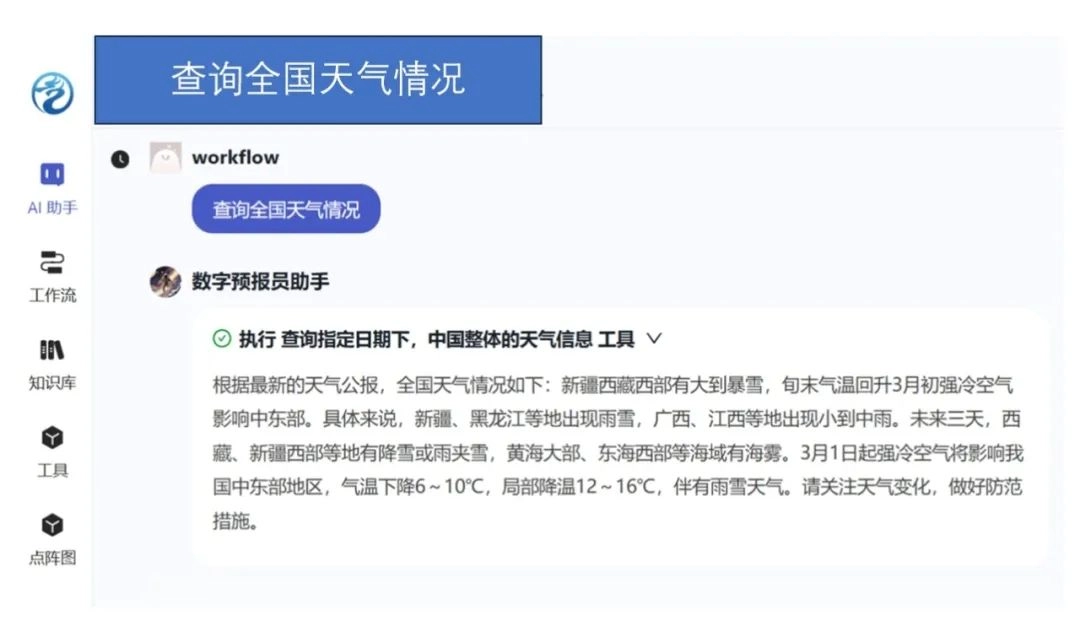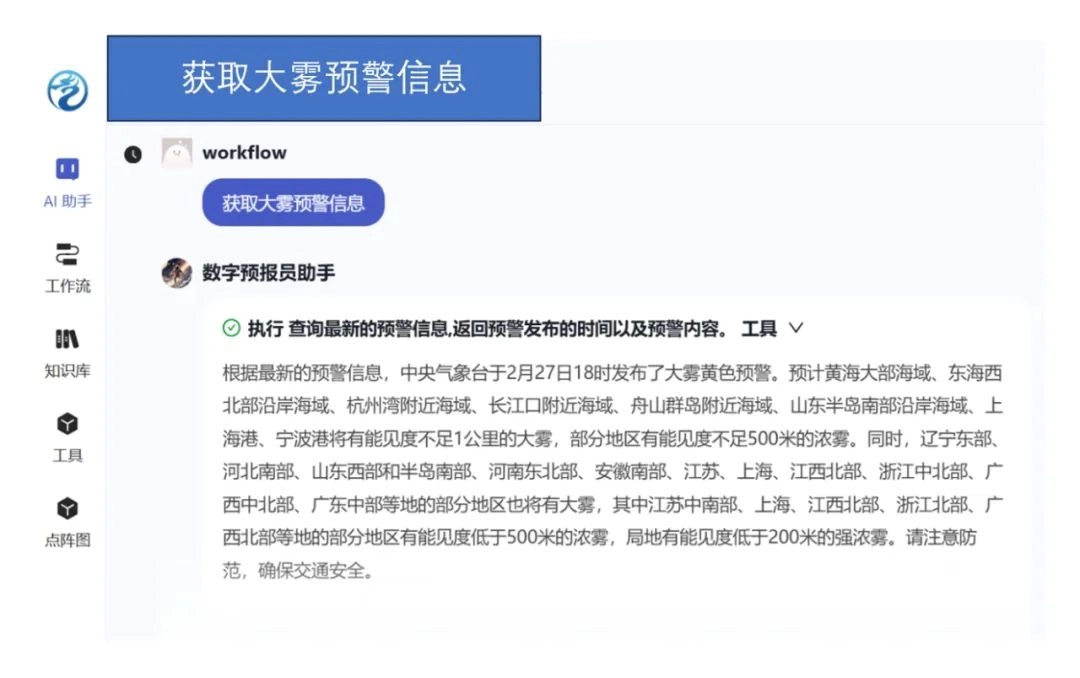
-
About
-
Product
-
Solution
-
Support
-
News
-
Join
 PubDate:2025-02-28
PubDate:2025-02-28
 ViewNum:50
ViewNum:50
With R&D investment well below the industry average cost
Multi-mode interaction, low energy operation, multi-language adaptation, etc
Key technological breakthrough
DeepSeek Further acceleration
The popularity of artificial intelligence applications

The China Meteorological Administration has also been trying to find out
How to activate AI in
The role of meteorological monitoring, forecasting and services
Meteorologists found
With deep learning algorithms
And the potential attention mechanism of bulls
Hybrid expert model architecture and other key technologies
DeepSeek can work in
Efficient processing of satellite imagery, radar data and ground observation data
Quickly analyze and refine complex critical meteorological information
Accelerate the pace of intelligent weather forecasting
And enable fine weather services and other aspects
Play an important role
It can be said that DeepSeek and other large language models are
We will accelerate the intelligent development of meteorological services
Provides a key "key"
Next, follow the editor together
Learn more about the application prospects of DeepSeek in the field of meteorology!
01
The whole process enables meteorological data information
Click to enter the meteorological big data cloud platform "Tianqing", more than 2,500 kinds of meteorological service data, more than 2,000 data elements, more than 1,000 data interfaces have been presented.

Meteorological big data cloud platform iterative upgrade Source: National Meteorological Information Center
"We developed ChatMUSIC, a smart 'little assistant,' because users have to spend time on the website to find the data or elements they need and choose the right interface to call services." According to He Wenchun, users only need to say the data they want through natural language dialogue, such as "get the data of the top 10 sites with the largest precipitation nationwide yesterday", and ChatMUSIC can immediately identify their needs, generate data acquisition code, and provide data samples and visual graphics.
ChatMUSIC is a microcosm of the National Meteorological Information Center (hereinafter referred to as the "Information Center") to explore the application of artificial intelligence in meteorology. On February 8, the Deepseek-R1 671B model completed localization deployment in the Meteorological Supercomputing Center (Helingel) of the China Meteorological Administration, docking ChatMUSIC with DeepSeek and starting to test web conversation interactive applications.
"From the current test, DeepSeek has strong computational analysis and model optimization capabilities, and its quality is better in reasoning logic, self-reflection, and semantic understanding and generation of Chinese language." He Wenchun introduced that such a strong inference model is of great significance for enabling the whole process of meteorological data.
In terms of data storage and services, large language models such as DeepSeek can reasonably plan and dynamically adjust data layout at all levels according to user access needs, optimizing user interaction experience in a more concise and natural way.
In Earth system science research, code writing and review is one of the key links, involving complex technical learning and grammatical analysis tasks. In the past, it took a lot of time and effort for researchers to write code, and mistakes were inevitable when the code was reviewed manually. Today, large language models such as DeepSeek can play a key role in this.
Recently, the Earth System Numerical Prediction Center of the China Meteorological Administration (hereinafter referred to as the "Numerical Prediction Center") has assisted scientific research with the DeepSeek-R1 large model.
By learning massive code data, it can quickly generate high-quality code frameworks based on natural language descriptions of researchers, covering Python, Fortran and other programming languages commonly used in earth science research. For the usual data processing and product rendering code development, just by interactively entering the code requirements in turn, the DeepSeek-R1 large model can quickly generate the basic code with a clear structure, and researchers can fine-tune it on this basis, shortening the development cycle.

The graph was generated under the guidance of DeepSeek
According to the characteristics of each component of the computer system, DeepSeek has carried out a lot of detailed optimization software design and development. "This is a good reference for the computational efficiency optimization of our next generation numerical prediction model, and the computational optimization of the subsequent model code needs to consider more hardware and software collaboration, and carry out elaborate design for machine characteristics." Lu Qifeng introduced.
In addition, the characteristic technology of DeepSeek model can also be applied in the development of numerical prediction models and various processes, such as the improvement and fusion of observation data preprocessing, assimilation minimization algorithm, four-dimensional variational linear adjoint equation solving, model dynamic calculation and other aspects by clever use of artificial intelligence technology, so as to improve accuracy and computational efficiency.
Faced with the processing and processing of massive meteorological data, DeepSeek can promote the high-quality integration of various heterogeneous and multi-modal remote sensing observation data such as weather radar and ground-based remote sensing, and help solve the problems of multi-source heterogeneity, spatio-temporal inconsistency and insufficient accuracy in the acquisition and processing of current meteorological monitoring data.
"We can also consider optimizing the location and layout of observation sites through intelligent algorithms, such as using genetic algorithms and simulated annealing algorithms to comprehensively consider factors such as terrain, population density, historical disaster records, and urban functional area distribution."
With the improvement of the algorithm, the proprietary layout model of the observation network is distilled to provide support for scientific planning of the observation network and improve the detection efficiency." Lei Yong introduced that by building a natural language model for equipment support and developing artificial intelligence conversational remote fault technical support system, it will also effectively improve the operation and maintenance support efficiency of meteorological observation data.
02
Deepening weather forecasting services in multiple scenarios
As a new star in the field of AI, DeepSeek has also profoundly affected the personalized upgrading of meteorological services, the enhancement of meteorological disaster early warning capabilities, and the deep integration of meteorological services and industries, injecting unprecedented momentum into meteorological forecasting and services.
Question 1: What can DeepSeek do for AI weather models?
In June last year, the China Meteorological Administration successively released "Fengqing", "Fenglei" and "Fengshun" three major meteorological forecasting models, and completed model training, testing and evaluation based on domestic global atmospheric reanalysis data CRA-40, radar observation data, and Fengyun satellite remote sensing data, further improving the prediction accuracy of atmospheric movement and weather phenomena.
In contrast, although the current DeepSeek and other large language models can not directly improve the accuracy of weather forecasting, "but the weather data includes satellite cloud images, radar echoes, ground observations, numerical model output and other multi-source heterogeneous data, with spatio-temporal dense, high-dimensional, multi-modal characteristics." DeepSeek cross-modal modeling (such as text-image training) technology can be used to build multi-modal fusion end-to-end models in meteorology (such as combining satellite imagery with numerical forecasting data) to improve the accuracy of severe weather forecasting." The journal said that we can also learn from its MoE expert model and other architectures to optimize the multi-task processing capability of large models of weather forecasting.
"The development of meteorological vertical industry models is an important direction for DeepSeek applications." Wang Yaqiang pointed out that DeepSeek's open source nature and local deployment capabilities make it easy to apply to the development of vertical industry models, while avoiding the risk of data leakage.
Meteorological vertical model can provide researchers with new help in inference diagnosis, question and answer service, intelligent agent and other aspects, as well as the construction of localized meteorological agents, so as to provide more solid support for the precision of meteorological forecasting.
In addition, the model training techniques used by DeepSeek can be borrowed from the development of large-scale AI models for weather forecasting. Model fine-tuning and knowledge distillation technology can extract the effective information from the meteorological physics model and simplify it into a more efficient and accurate calculation model, so as to effectively improve the prediction ability and accuracy of the large meteorological forecast model. Knowledge distillation technology can also significantly reduce the computing power and storage requirements of large model training, improve the efficiency and accuracy of model training, and provide more efficient solutions for weather forecasting and service. In addition, the addition of reinforcement learning technology can provide support for the professional expansion of large weather forecasting models in environmental meteorology, traffic meteorology, agricultural meteorology and other fields.
Q2: What are the meteorological departments doing about smart weather services?
In terms of intelligent meteorological services, the National Meteorological Center launched the construction of a next-generation weather forecast business integration platform with "intelligent brain" as the core in 2023. By building a forecaster agent based on a large language model - "digital forecaster Assistant", forecasters can achieve significant efficiency improvements in weather analysis, model diagnosis, forecast research and judgment, and product generation.

The picture shows digital forecaster assistant checking the national weather situation Source: National Meteorological Center

The picture shows digital forecaster assistant to obtain fog warning information source: National Meteorological Center
With the development of technology and service upgrading, meteorological service is not only a simple output of weather forecast, personalized and accurate meteorological service system has gradually become a new trend in the development of the industry. Wang Muhua believes that DeepSeek's advantages in deep inference technology can be used to perform complex multi-step research tasks, effectively improving the accuracy of meteorological data retrieval and the quality of service content generation.
At the same time, the Public Meteorological Service Center of the China Meteorological Administration has integrated DeepSeek-R1 into the "Fenghe" meteorological service model, greatly improving the model's deep reasoning ability. This model relies on Zhibian GLM and other open source general large models, combined with large-scale meteorological books, meteorological science popularization websites, meteorological service materials and other professional meteorological corpus and knowledge base, pre-training and fine-tuning, to build a large vertical base model of meteorological service.

The picture shows the page of "Fenghe" large model. The picture is provided by the Public Meteorological Service Center of China Meteorological Administration
Through the AI Agent platform (a system driven by a large language model as the brain), expand access to authoritative meteorological data and meteorological tools, and build a weather service agent platform based on "wind and" to adapt to different application scenarios.
Through technological innovation, meteorological services have not only been significantly improved in accuracy and timeliness, but also deeply integrated with agriculture, transportation, energy, tourism, health and other industries, providing more accurate and efficient meteorological support for the development of various industries, and forming a new ecology of intelligent application of meteorological services.
03
Challenges and opportunities
At present, DeepSeek's full adoption still faces some challenges. Large language model is not "out of the box", the current meteorological department to build intelligent application environment and existing business algorithms, plug-ins, interfaces and other development resources have not been fully connected, and has not established a complete rules, unified standards, safe and reliable artificial intelligence meteorological corpus.

Source: Team of Meta-Cosmic Culture Lab, New Media Research Center, School of Journalism and Communication, Tsinghua University "DeepSeek from Entry to Mastery"
At present, meteorological departments at all levels are exploring and promoting the application of DeepSeek. The Information Center is accelerating the construction of the meteorological artificial intelligence basic support technology platform, providing users with a unified deployment of large models and a one-stop intelligent application development environment, upgrading the capabilities of the meteorological big data cloud platform, providing unified support for data, computing power, algorithms, components, interfaces, intelligence, etc., to ensure stability and security.
With the rapid development of artificial intelligence technology, the field of meteorology is ushering in profound changes. However, how to combine these cutting-edge technologies closely with the actual needs of meteorological operations is still a topic worthy of in-depth discussion.
This requires meteorological departments to actively promote the application of technology at the same time, more carefully think about how to pay attention to multi-dimensional cooperation and exploration, to ensure that the model can truly provide practical solutions for meteorological forecasting, climate change research, disaster response, etc., and write "high-quality" annotations for the development of meteorological undertakings.


 WeChat
WeChat
 T1-11F, Herui Science and Technology Park, Binjiang District, Hangzhou City, Zhejiang Province
T1-11F, Herui Science and Technology Park, Binjiang District, Hangzhou City, Zhejiang Province